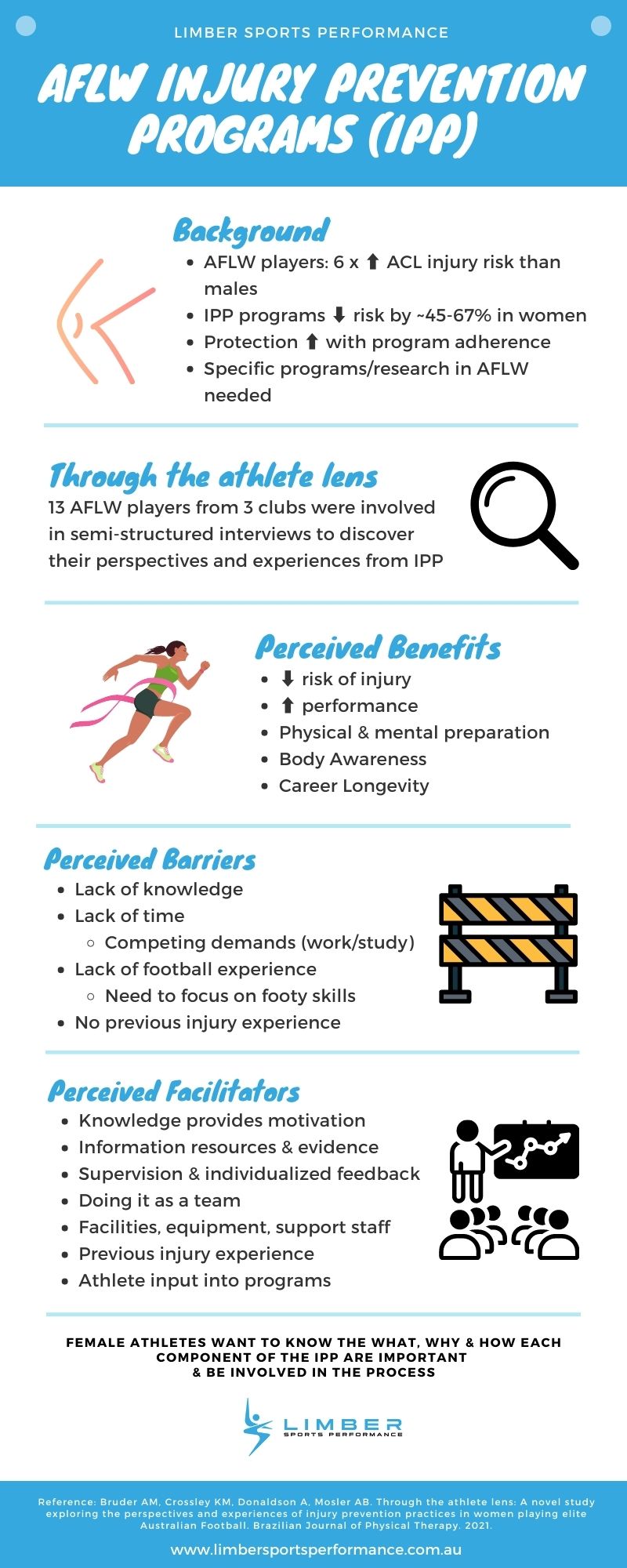AFLW Athlete Perspectives on Injury Prevention Programs
Through the Athlete Lens….
Many popular Injury Prevention Programs exist (eg: FIFA 11+, Netball Australia Knee Program) and multicomponent injury prevention programs have been researched extensively.1,2 However, effective translation in real world sports settings can present some challenges. A recent study published by La Trobe University Australia, explored the perspectives and experiences of injury prevention programs by 13 AFLW players from three clubs.3 While some of the findings were not so surprising (such as the athletes’ perceived benefits from the programs), there were several insights into the perceived barriers and facilitators to success.
The infographic below summarises key points from the paper which can be used by clubs and staff who seek a greater understanding of the end-user’s perspective to guide and evolve existing programs. Key quotes from the paper are also discussed below.

Giving athletes a voice can be a key step in improving the success of injury prevention in sport, especially in relatively young sports such as AFLW. Injury prevention program implementation and adherence is complex and multifactorial, and the AFLW players interviewed acknowledge this sentiment. The findings of the exploratory research interviews, highlight the varying levels involved from an individual, interpersonal, club and organisational level, and how these can affect the player. On a personal level athletes were aware of the risks and benefits in a general nature, but possibility not when relating each component of the program to the overall goals. Athletes were seeking more educational resources to be available such as infographics, videos, education presentations, and some even wanted to know the evidence base for the exercises to ensure they were making the most of their time. Whether this desire for more knowledge differs between female and male athletes would be an interesting topic, but it seems clear the female athletes in this study wanted to be informed as much as possible.
Athletes took some responsibility for adherence to the programs, along with viewing their coaches, medical staff and team mates as playing important roles. While the design and delivery of the program was a team effort amongst staff, the athletes indicated a desire for a more active role in this process, one player saying “I think we know our bodies, so we could (be involved) in coming up with the program.” Including athletes in this process (once educated) may increase ownership and motivation to commit to injury prevention programs.
There were comments alluding to the benefit of performing exercises in a team environment to increase enjoyment but on the flip side there were requests for support and feedback on an individual level. Combining team activities with personal exercises periodically supervised by support staff may present an ideal balance based on the feedback. There was also a desire for the programs to be designed for women and not simply be a copy or adaption of the mens AFL program. Position specific programs was also another idea presented. A lack of support staff and at times access to space within facilities and equipment was mentioned by some athletes.
No athletes linked the benefits of injury prevention to improved team success with less injuries, despite clear evidence existing in this area.4 An intention to commit to injury prevention programs was indicated by most AFLW players. However, barriers were identified such as the competing demands of a part-time athlete on both a personal and organisational level and not being able to arrive early to training to perform the required exercises. Juggling full-time work or study will continue to be a challenge for AFLW players, as well as the urgency to improve football skills, particularly for those who are new to the sport. Support from the sports coaches as to the importance of injury prevention is needed on this front so players are not feeling conflicted with their priorities. Team culture and environment could also aid or hinder individual athlete behaviour in terms of IP adherence. In conclusion, AFLW players value the development of injury prevention programs within their sport and seek specificity, support and personal involvement in this ongoing process. A fantastic study and well worth a read in full if you have time.
If you are interested in a personalised injury prevention program for your sport, contact us about our tailored Limber Longevity Neuromuscular Training Programs.
References:
- Crossley KM, Patterson BE, Culvenor AG, Bruder AM, Mosler AB, Mentiplay BF. Making football safer for women: a systematic review and meta-analysis of injury prevention programmes in 11 773 female football (soccer) players. Br J Sports Med. 2020;54(18):1089-1098.
- Webster KE, Hewett TE. Meta‐analysis of meta‐analyses of anterior cruciate ligament injury reduction training programs. Journal of Orthopaedic Research®. 2018;36(10):2696-2708.
- Bruder AM, Crossley KM, Donaldson A, Mosler AB. Through the athlete lens: A novel study exploring the perspectives and experiences of injury prevention practices in women playing elite Australian Football. Brazilian Journal of Physical Therapy. 2021.
- Drew MK, Raysmith BP, Charlton PC. Injuries impair the chance of successful performance by sportspeople: a systematic review. Br J Sports Med. 2017;51(16):1209-1214.
